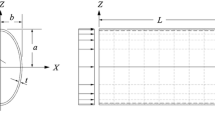Abstract
In this paper, the influence of ellipticity ratio on energy absorption capability and load-carrying capacity of woven roving wrapped composite elliptical tubes has been investigated both experimentally and numerically. A series of experiments was conducted for composite elliptical tubes with ellipticity ratios (a/b) ranging from 1 to 2. Typical failure histories of their failure mechanism are presented and discussed. The experimental data are correlated with predictions from a finite element model. Load-deformation curves and deformation histories of typical specimens are presented and discussed. For all specimens considered, classical axial collapse eigenvalues were computed. The results showed that the ellipticity ratio significantly influenced the energy absorption capabilities as well as the load-carrying capacity. Tubes with ellipticity ratios of a/b 1.25 and 2.0 displayed the highest normalised specific energy absorption capability. A reasonable agreement between the experimental and computational results was obtained for the critical crush load.
Similar content being viewed by others
References
Johnson, W. and Reid. S. R., ‘Metallic Energy Dissipating Systems’, Applied Mechanics Review 31, 1978, 27–288.
Reid, S. R., Reddy, T. Y. and Gray, M. D., ‘Static and Dynamic Axial Crushing of Foam-Filled Sheet Metal Tubes’, International Journal of Mechanical Science 28, 1986, 29–322.
Thomas, S. G., Reid, S. R. and Johnson, W., ‘Large Deformation of Thin Walled Circular Tubes under Transverse Loading-I’, International Journal of Mechanical Science 18, 1976, 32–333.
Johnson, W. and Reid, S. R., ‘Metallic Eenergy Dissipating Systems’, Applied Mechanics Review 31, 1978, 27–288.
Wu, L. and Carney III, J. F., ‘Initial Collapse of Braced Elliptical Tubes under Lateral Compression’, International Journal of Mechanical Science 39, 1997, 102–1036.
Wu, L. and Carney III, J. F., ‘Experimental Analyses of Collapse Behaviours of Braced Elliptical Tubes under Lateral Compression’, International Journal of Mechanical Science 40, 1998, 76–777.
Hull, D., ‘Energy Absorption of Composite Materials under Crash Conditions’, in: Progress in Science and Engineering of Composites, Proceedings of the 4th International Conference on Composite Materials (ICCM/4), Tokyo, 1982, pp. 86–870.
Mahdi, E., Sahari, B. B., Hamouda, A. M. S. and Khalid, Y. A., ‘Crushing Behaviour of Cone-Cylinder-Cone Composite System’, Mechanics of Composite Materials and Structures 9, 2002, 9–117.
Hull, D., ‘A Unified Approach to Progressive Crushing of Fibre-Reinforced Composite Tubes’, Composite Science and Technology 35, 1993, 23–246.
Mamalis, A. G. and Johnson, W., ‘The Quasi Static Crumpling of Thin Walled Circular Cylinders and Frusta under Axial Compression’, International Journal of Mechanical Science 25, 1983, 71–731.
Mamalis, G. D., Manolakos, E., Demosthenous, G. A. and Ioannidis, M. B., ‘Analytical Modelling of the Static and Dynamic Axial Collapse of Thin-Walled Fibreglass Composite Conical Shells’, International Journal of Impact Engineering 19, 1997, 47–492.
Farley, G. L. and Johnson, R. M., ‘Analogy for the Effect of Material and Geometrical Variables on Energy Absorption Capability of Composite Tubes’, Journal of Composite Materials 26, 1992, 7–90.
Farley, G. L., ‘Energy Absorption in Composite Structures’, Journal of Composite Materials 17, 1983, 26–279.
Mahdi E., Sahari, B. B., Hamouda, A. M. S. and Khalid, Y. A., ‘Effect of Hybridisation on Crushing Behaviour of Carbon/Glass Fibre/Epoxy Circular Cylindrical Shells’, Journal of Materials and Processing Technology 132(1–3), 2002, 4–57.
Mahdi, E., Sahari, B. B., Hamouda, A.M. S. and Khalid, Y. A., ‘An Experimental Investigation into Crushing Behaviour of Filament Wrapped Laminated Cone-Cone Intersection Composite Shell’, Composite Structures 51, 2001, 21–219.
Farley, G. L. and Jones, R. M., ‘Crushing Characteristics of Composite Tubes with Near-Elliptical Cross-Section’, Journal of Composite Materials 26, 1992, 174–1752.
Meyres, C. A. and Hyer, M. W., ‘Response of Composite Elliptical Cylinders to Axial Compression Loading’, Mechanics of Composite Materials and Structures 6, 1999, 16–194.
LUSAS/Standard User's Manual, LUSAS theory manual, version 13.3.
Reddy, J. N. and Bert, C. W., ‘On Behaviour of Plates Laminated of Biomodulus Composite Materials’, VP1 and SU report VP1-E-81-11 and OU-MNE-81-1, April 1981.
Author information
Authors and Affiliations
Rights and permissions
About this article
Cite this article
Alkoles, O.M.S., Mahdi, E., Hamouda, A.M.S. et al. Ellipticity Ratio Effects in the Energy Absorption of Axially Crushed Composite Tubes. Applied Composite Materials 10, 339–363 (2003). https://doi.org/10.1023/A:1025766609635
Issue Date:
DOI: https://doi.org/10.1023/A:1025766609635




